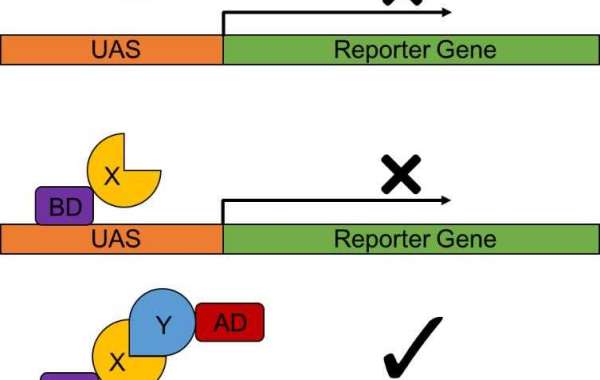Protein-protein interactions (PPI) are the cornerstone of diverse cellular processes, comprising signal transduction, gene regulation, and metabolism, among others. The complexity of PPIs necessitates a deep comprehension of their molecular mechanisms, which can aid in the development of novel therapies and drugs for a broad spectrum of illnesses.
The yeast two-hybrid (Y2H) assay is a prevalent technique used to investigate PPIs. This assay enables researchers to explore protein interactions in vivo, rendering it a powerful tool for identifying and characterizing such interactions. By capturing the perplexity of PPIs, the Y2H assay allows for a more comprehensive understanding of their molecular underpinnings, opening new avenues for therapeutic development.
How Does Yeast Two-Hybrid Work?
The Y2H system is based on the modular nature of transcriptional activators in yeast, which consist of a DNA-binding domain (DBD) and an activation domain (AD). In the Y2H assay, the DBD and AD are fused to two different proteins of interest, known as the bait and prey, respectively. If the bait and prey proteins interact in vivo, the DBD and AD are brought into close proximity, allowing for transcriptional activation of a reporter gene. The most commonly used reporter genes are HIS3 and lacZ, which allow for selection and screening of positive interactions.
The Y2H assay can be performed using two different strategies: the Gal4-based system and the LexA-based system. In the Gal4-based system, the DBD and AD are derived from the yeast Gal4 transcriptional activator, while in the LexA-based system, they are derived from the bacterial LexA repressor. Both systems have their advantages and disadvantages, and the choice of system depends on the specific application.

What is the Application of Yeast Two-Hybrid Assay?
The assay known as Y2H is renowned for its vast array of applications in both basic and applied research. One of the foremost applications is the detection of hitherto unknown protein-protein interactions, an endeavor that can yield precious insights into the functioning of proteins that have yet to be characterized. A sterling example of this is the usage of Y2H screening to pinpoint novel interactors for the tumor suppressor protein p53, a development that has helped shine a light on its role in the onset of cancer.
The Y2H assay can also be leveraged for the purpose of studying the specificity and affinity of known interactions. By systematically inducing mutations in the bait and prey proteins, researchers are able to uncover the specific amino acid residues involved in the interaction and assess the strength of the interaction, an invaluable tool in the arsenal of modern-day researchers.
Another vital application of the Y2H assay lies in the realm of drug discovery. Through the screening of large libraries of compounds for their potential to disrupt protein-protein interactions, researchers can zero in on potential drug candidates for a wide variety of afflictions. Notably, Y2H screening has been utilized to identify compounds that can effectively inhibit the interaction between the hepatitis C virus NS5A protein and the host protein cyclophilin A, paving the way for the development of a new range of antiviral drugs.
 Y2H methods and their applications to detect protein–protein or protein–small-molecule interactions and to discover small-molecule inhibitors (Hamdi et al., 2012)
Y2H methods and their applications to detect protein–protein or protein–small-molecule interactions and to discover small-molecule inhibitors (Hamdi et al., 2012)
Difference between Yeast 1 Hybrid/Yeast 2 Hybrid/Yeast 3 Hybrid
The utilization of the Y2H assay has been widespread when it comes to studying Protein-Protein Interactions (PPIs). However, throughout the years, several other variations of this assay have been developed. Among them, the yeast one-hybrid (Y1H) assay shares the same principles as the Y2H assay, with a twist. Instead of focusing on protein-protein interactions, the Y1H assay is utilized for testing protein-DNA interactions. The protein of interest is fused to the DNA binding domain (DBD), whereas the prey consists of a DNA fragment containing a binding site for the DBD. The activation of the reporter gene occurs if the protein of interest binds to the DNA fragment.
In contrast, the yeast three-hybrid (Y3H) assay is a modification of the Y2H assay that has been developed to enable the detection of ternary protein complexes. By introducing a bridge protein, which interacts with the bait protein and a third protein, also known as the target protein, the Y3H assay permits the formation of ternary complexes. If the bait and target proteins also interact, the reporter gene is transcribed.
Although the Y2H assay remains the most common method for studying PPIs, the Y1H and Y3H assays possess their own unique benefits and uses. For instance, the Y1H assay is well-suited for studying the binding specificity of transcription factors to DNA. In comparison, the Y3H assay is useful in identifying proteins that interact with specific domains of a target protein.
Reference
- Hamdi, Amel, and Pierre Colas. "Yeast two-hybrid methods and their applications in drug discovery." Trends in pharmacological sciences 33.2 (2012): 109-118.








